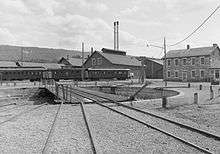Sioux City & Pacific Railroad Co. v. Stout
| Sioux City & Pacific R.R. Co. v. Stout | |
|---|---|
 | |
| Decided January 26, 1874 | |
| Full case name | Sioux City & Pacific R.R. Co. v. Stout |
| Citations | 84 U.S. 657 (more) |
| Court membership | |
| |
| Case opinions | |
| Majority | Hunt, joined by unanimous |

Sioux City & Pacific Railroad Co. v. Stout, 84 U.S. (17 Wall.) 657 (1873), was a case decided by the Supreme Court of the United States that first enunciated the idea that a landowner could be liable for the injuries of a child trespasser.
Events
On March 29th, 1869, a small child was injured by a railroad turntable owned by Sioux City and Pacific Railroad, which was being operated in Blair, Nebraska. The child was playing on the turntable, which injured his/her foot. The father took the company to court in Nebraska, but it was removed to the Supreme Court.
Decision
A child was injured by a railroad turntable owned by Sioux City and Pacific Railroad, which was being operated in Blair, Nebraska. Sioux City & Pacific Railroad company was held liable, despite the prevailing idea that a landowner was not held liable for injuries to trespassers. Trespassing children were thought to be a special case that required a higher duty of care. This theory of liability came to be known as the "turntable doctrine" and later the attractive nuisance doctrine by the case Keffe v. Milwaukee & St. Paul R.R. Co.
See also
External links
- Text of Sioux City & Pacific R.R. Co. v. Stout, 84 U.S. (17 Wall.) 657 (1873) is available from: Cornell Justia Library of Congress OpenJurist